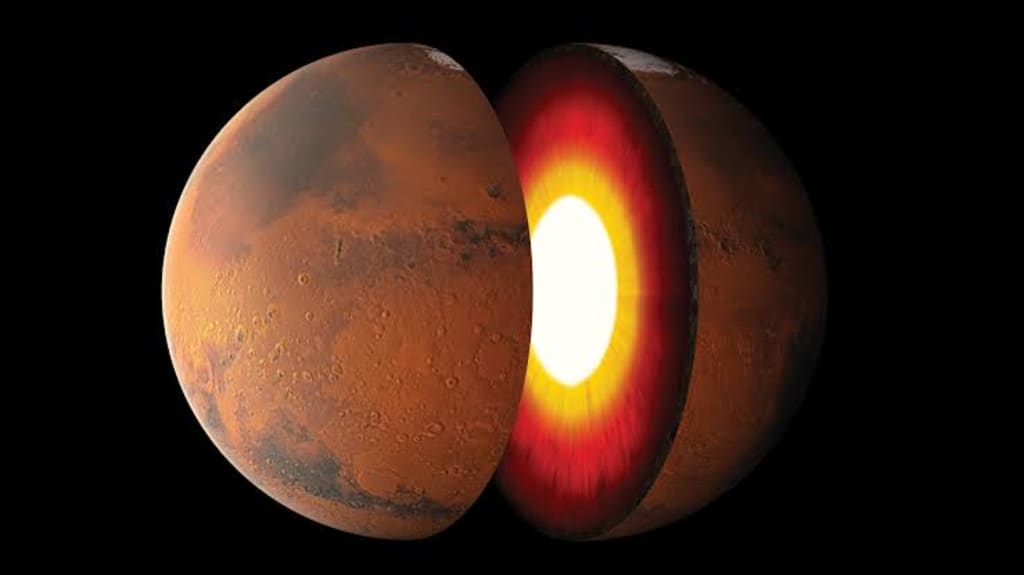Mars, also known as the Red Planet, is the fourth planet from the sun in our solar system.
Mars has a thin atmosphere, which is mostly carbon dioxide, with traces of nitrogen and argon. The atmospheric pressure on Mars is only about 1% of Earth's, which means that liquid water cannot exist on the surface for very long. However, there is evidence that water may exist in the form of ice on the planet's polar ice caps and in underground reservoirs.

1.Mars is the fourth planet from the sun in our solar system.
It is a terrestrial planet, meaning it is composed primarily of rock or metal.
Mars has a thin atmosphere, mostly made up of carbon dioxide, with traces of nitrogen and argon.
2.The atmospheric pressure on Mars is only about 1% of Earth's, which means that liquid water cannot exist on the surface for very long.
Mars has a day that is slightly longer than Earth's, with a rotation period of 24.6 hours.
3.Mars is approximately half the size of Earth, with a diameter of about 6,780 kilometers (4,212 miles).
4.Mars is known for its distinctive reddish color, which is due to the presence of iron oxide, or rust, on its surface.
5.The largest volcano on Mars, Olympus Mons, is the largest known volcano in the solar system.
6.Mars is home to the deepest canyon in the solar system, Valles Marineris, which stretches over 4,000 kilometers (2,500 miles) long and up to 7 kilometers (4.3 miles) deep.
7.Mars has been the subject of many space missions, with numerous rovers, landers, and orbiters sent to study the planet.
8.Mars, also known as the Red Planet, is the fourth planet from the sun in our solar system. It is named after the Roman god of war, likely due to its reddish appearance in the sky. Mars is a terrestrial planet, meaning it is composed primarily of rock or metal.
9.Mars has a thin atmosphere, which is mostly carbon dioxide, with traces of nitrogen and argon. The atmospheric pressure on Mars is only about 1% of Earth's, which means that liquid water cannot exist on the surface for very long. However, there is evidence that water may exist in the form of ice on the planet's polar ice caps and in underground reservoirs.
10.Mars has been the subject of many space missions, with numerous rovers, landers, and orbiters sent to study the planet.
Mars has been the subject of many space missions, with numerous rovers, landers, and orbiters sent to study the planet. The first successful mission to Mars was NASA's Mariner 4, which flew by the planet in 1965 and returned the first close-up images of the Martian surface.
The most recent and significant missions to Mars are NASA's Perseverance and China's Tianwen-1, both of which landed on the planet in February 2021. Perseverance carries a suite of scientific instruments, including a high-resolution camera, a spectrometer, and a ground-penetrating radar, among others. Its primary goal is to search for signs of ancient life on the planet and to collect and store samples of Martian rock and soil for future return to Earth.
Tianwen-1, on the other hand, consists of an orbiter, a lander, and a rover. Its main objectives are to study the geology, topography, and atmosphere of Mars, as well as to search for signs of water and ice on the planet's surface.
The surface of Mars is rocky and barren, with a landscape marked by craters, volcanoes, and valleys. The planet's largest volcano, Olympus Mons, is the largest known volcano in the solar system, standing at a height of 22 kilometers (13.6 miles). The planet is also home to the deepest canyon in the solar system, Valles Marineris, which stretches over 4,000 kilometers (2,500 miles) long and up to 7 kilometers (4.3 miles) deep.
Mars is known for its distinctive reddish color, which is due to the presence of iron oxide, or rust, on its surface. The planet's thin atmosphere allows more of the sun's ultraviolet radiation to reach the surface, which breaks down rocks and soil into iron oxide.
In terms of its potential as a future human settlement, Mars is often considered the most viable planet in our solar system due to its proximity to Earth, relatively moderate climate, and the possibility of water resources. However, there are many challenges to overcome before humans can colonize Mars, including the harsh environment, lack of oxygen and atmosphere, and the need for sustainable sources of food and water.
Overall, Mars is a fascinating planet with a rich history of exploration and scientific discovery. With ongoing missions and future plans for human exploration, there is still much to learn about this mysterious world.
About the Creator
Enjoyed the story? Support the Creator.
Subscribe for free to receive all their stories in your feed. You could also pledge your support or give them a one-off tip, letting them know you appreciate their work.





Comments
There are no comments for this story
Be the first to respond and start the conversation.